ItsYerChoice Game
The ultimate game for teaching self control over all future reinforcers!
Get Your Free eBook
To receive the complete game in downloadable eBook format, leave your name and email address and we will send it along to you.
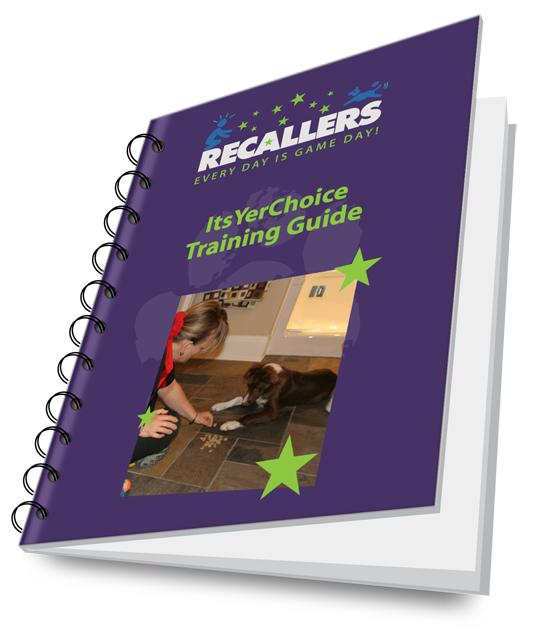
 ItsYerChoice is a critical core foundation game we play here at Say Yes Dog Training. A way of life where our dogs learn all things of value must be earned. The premise of the game is that the “work” is what earns the reward not just the presence of those rewards in the environment.
ItsYerChoice is a critical core foundation game we play here at Say Yes Dog Training. A way of life where our dogs learn all things of value must be earned. The premise of the game is that the “work” is what earns the reward not just the presence of those rewards in the environment.
ItsYerChoice can be played with anything the dog finds reinforcing such as: toys, people, other animals and environments (e.g. water). This game allows the dog the freedom to choose his own actions which may, through correct choices, earn the reinforcement he wants so badly!
Choosing correctly earns the dog the reinforcement and teaches a strong foundation of self control! WE are no longer responsible for telling the dog words like “leave it!” or “aah aah” but rather they control themselves around things they love waiting for the words “go see” or “get it” for great self control choices. Our only job is to observe behaviour and choices, and if an incorrect choice is made YOU may need to control the reinforcement (not the dog), preventing access to the reinforcement should they
make an incorrect choice.
ItsYerChoice: The Game of Self Control
Many dog trainers rely on the cue “leave it” to control their dog from stealing reinforcement. You will hear this phrase in an effort to stop a dog from getting food from the kitchen counter, out of the trash, or from eating or rolling in something unpleasant found in the grass. It is also a phrase you will commonly hear in training for a dog that sniffs (seeking reinforcement or possibly showing signs of stress) or for a dog that leaves his owner to steal a toy, or to run off to visit or for dozens of other reasons. Rarely, if ever, is this cue said with a pleasant tone of voice. It is meant to intimidate in an effort to stop an unwanted response. However, the “leave it” cue actually rewards the dog rather then punishes him. Let’s examine this concept.
All cues (words that prompt a response from your dog) are a form of reinforcement. The cue rewards the dog for what he is doing when he hears you prompt his next response. The cue itself carries the historic value of all previous reinforcement you built in when you trained the behavior. For example, teaching a “come” cue. You call the dog, he comes to you, and he gets a reward. Eventually you call and he comes running as the cue prompts an expectant response of a cookie from you. Every cue your dog understands carries this value.
All cues required some form of reinforcement when you trained them so all cues give the dog reinforcement. Suppose while practicing a recall you ask your dog to sit, leave him and when you turn he is out of the sit and sniffing. Would you tell him to “come”? I hope not because doing so is rewarding the dog for what he is doing when he hears the cue. He disobeyed and left the sit. Your “come” cue would reward that response from him. Reinforcement builds behavior therefore in giving your dog his next cue (in this case “come”) you would be rewarding something you didn’t want repeated (him leaving his sit position).
That is exactly what the cue “leave it” accomplishes. It rewards the dog for what he is doing when he hears the cue. In all cases the dog is doing something you do not want to see repeated, so why reward it? People use the “leave it” as a way of imposing their control over their dog when the dog is faced with an opportunity to steal reinforcement. Imposed control is a lot of work for the trainer. By reinforcing unwanted behaviors with your “leave it” cue you have ensured the dog will continue these rehearsals (of attempting to steal reinforcement). You are letting the dog know he may continually hunt for his own reinforcement and you will always be there to manage the environment and every speck of potential reinforcement found in it! You are resigned to a life time of “leave it!” duty whenever your dog is faced with any choices. What if the dog sees the distraction first? He will have made the decision to eat it or take off to investigate it long before you have a chance to get out a single “leave it!” cue. What happens also when the dog is off leash far enough away that he is out of your control? What is the likelihood he will really leave it then?
ItsYerChoice to the Rescue
The ItsYerChoice game changes all of this. This game is about controlling the consequences of the dog’s choice rather than trying to control the dog.
We start small and teach the dog that he always has a choice. If he chooses correctly when working with you, good consequences will follow (the chance for reinforcement). If the dog makes an inappropriate choice the consequences for him will be clear and not reinforcing. But the consequences will never be a function of you trying to coach or intimidating the dog in any way. In the end we teach the dog self control rather then imposed control. A dog with self control has learned to have impulse control when in stimulating environments. Rather than leave you to chase the squirrel, steal a toy or investigate every crumb that may be on the ground, the dog will play your game knowing rewards will be earned contingent upon him following your rules.
The ItsYerChoice game starts out teaching your dog to make easy decisions when faced with a chance to steal rewards. Building upon his successes you can grow this game into any form of distraction training you can imagine. Eventually your dog’s impulse control becomes so brilliant you can trust him unsupervised with a roast on the kitchen counter within his reach. The dog will learn to want to make the right choice. This is self control and does not require your eagle eye scouting every training horizon for distractions that may cause your dog to leave you in search of alternate rewards.
The ItsYerChoice Tennis Match
Start with some tasty treats. Choose the rewards wisely. A chow hound that gets out of control with arousal does not need high value rewards. Perhaps boring kibble will do for this pooch. A dog that is less food motivated will require the “high test fuel”. Choose really outstanding treats. You will want a fistful of treats but make sure none can be seen or stolen through the cracks of your clenched fist. Think of this game as a tennis match. One player serves, the other volleys. This back and forth flow of responses continues through the entire game. You are serving first. Sit in a comfortable chair resting your wrist on your knee giving it support so it won’t move when your dog investigates the hidden treats. Now it is your dog’s turn to return your serve. Normally if your dog is presented with a handful of cookies it is very likely he will try to steal them. It is an impulse and there is presently no impulse control. But this game is a model for great control. Currently there is a classically conditioned response in your dog that you are going to change. You will counter condition his response so he will show great self control when presented with the treats. Eventually your dog will move away from the cookies and wait. Remember it’s his choice so we allow him to do whatever he chooses. He may start by sniffing, then licking, possibly pawing and even nibbling on your hands to get at the treats. In your tennis match all of these responses are “out-of- bounds”. You do not need to volley back to him as he has not hit the response you desire. So offer nothing, say nothing, do nothing. He has not demonstrated self control. With a really food driven dog this may take a few minutes or longer so be patient (go to your “Zen” happy place). Make certain not to move your hand as that turns the game into one of chase the moving prey. Your dog will be even keener to hunt it down rather than back away.
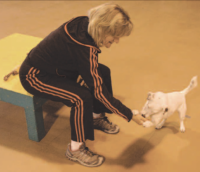
He may start by sniffing, then licking, possibly pawing and even nibbling on your hands to get at the treats. Offer nothing, say nothing,do nothing.
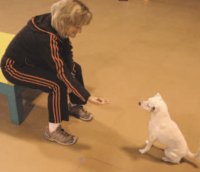
He will eventually back away from the hand. When he does (provided he isn’t barking at you), open your hand. The sight of the foodlying in your open hand is very reinforcing.

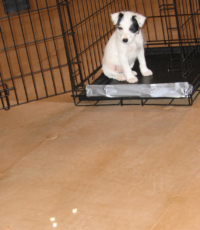 If every undesirable response from your dog is met with a non-response from you he will eventually back away from the hand. When he does (provided he isn’t barking at you) open your hand. By opening your hand you have reinforced the first appropriate choice your dog has made. The consequences are quite pleasant for the dog as he has gotten you to do what he wants! You do not have to actually feed the dog to reward him. The sight of the food lying in your open hand is very reinforcing. Can you predict your dog’s response to this open handful of cookies? Of course! He will see the treats and try to dive in at them. He has hit the ball back to you and it is your turn to close your fist around the treats once more. The consequences of the dog’s behavior (you controlling his access to the good cookies) will eventually cause him to choose a different response. But it will be HIS choice of responses, him showing self control. You are only controlling the consequences and the dog is controlling his impulses. Keep this game of opening and closing your hand going until your dog will not move towards the food when he sees it in your open hand. Now verbally praise him. When you do (this will be the first time you have spoken during the game) he will likely once again move forward as praise is a predictor of a reward for him. Close the fist. Only when he can demonstrate great self control should you pick up a treat to reward him. HOWEVER, if when you touch a treat he moves to get it from you…you know the drill. Put the cookie back into your hand and close it once more. Your dog should only get a treat if you can praise him, pick up a treat and move it towards him. Only then should you reinforce his self control. Many people when playing this game are looking for an excuse to feed their dog. A better approach is to observe the dog and search for a response to reward. The consequences of the game are teaching the dog to have self control.
If every undesirable response from your dog is met with a non-response from you he will eventually back away from the hand. When he does (provided he isn’t barking at you) open your hand. By opening your hand you have reinforced the first appropriate choice your dog has made. The consequences are quite pleasant for the dog as he has gotten you to do what he wants! You do not have to actually feed the dog to reward him. The sight of the food lying in your open hand is very reinforcing. Can you predict your dog’s response to this open handful of cookies? Of course! He will see the treats and try to dive in at them. He has hit the ball back to you and it is your turn to close your fist around the treats once more. The consequences of the dog’s behavior (you controlling his access to the good cookies) will eventually cause him to choose a different response. But it will be HIS choice of responses, him showing self control. You are only controlling the consequences and the dog is controlling his impulses. Keep this game of opening and closing your hand going until your dog will not move towards the food when he sees it in your open hand. Now verbally praise him. When you do (this will be the first time you have spoken during the game) he will likely once again move forward as praise is a predictor of a reward for him. Close the fist. Only when he can demonstrate great self control should you pick up a treat to reward him. HOWEVER, if when you touch a treat he moves to get it from you…you know the drill. Put the cookie back into your hand and close it once more. Your dog should only get a treat if you can praise him, pick up a treat and move it towards him. Only then should you reinforce his self control. Many people when playing this game are looking for an excuse to feed their dog. A better approach is to observe the dog and search for a response to reward. The consequences of the game are teaching the dog to have self control.
Be aware of what your dog is doing when you reinforce him. What position is he in? You want him to back away from you but you
don’t want the dog to think his reinforcement is tied to one body position or movement. Make sure he is rewarded in a sit, down or stand randomly and don’t open your hand when he is still moving (or you will be building in a “back up” into the game).
Advancing the Choices
Eventually you can get out of your chair and put all the cookies in a pile on the floor with your hand covering them. You have changed the learning environment for the dog but success in this habitat will help the dog to generalize his new self control to all environments. At first your dog may resort to his old ways, trying to steal the cookies. Once again say and do nothing and wait until he moves away from your hand. When he does, lift up your hand and start the back and forth rally with him until he shows enough self control that you can praise him, pick up a cookie and feed him without him moving forward.
Once your dog is excelling with this game, test him further by using higher value food rewards. The higher the value of the treat the more of a distraction they will present; thus the more challenge to your dog’s self control. Try food he loves or food he has never had. This is a great “TV” game. You can lounge on the floor and work towards putting a cookie on your dog’s paw or one on both paws or the top of his head! He must ignore the cookie in order to earn the cookie. When you are ready, tap your finger in front of the cookie and tell him to “get it”. Be light hearted and it will be fun for both of you. You can also try this game during formal training. Have your dog in a sit, praise him and walk towards him to feed him. Does he break position to help ‘facilitate’ your feeding him? If so retreat and start again. Just because you were going to reward him does not give him permission to stop his work or to jump on you. Try the game with him holding a contact position in agility. Does he move his paws or try to come out of position when you feed him. If so close your fist around the cookie and move away to try again. It is about self control in all environments but the game remains the same. You control the consequences not the dog.
The advanced stage of ItsYerChoice with food involves food on the floor and the dog moving. Allow your dog to watch you drop a treat on the floor. If he dives at it you can step on the cookie to control his access to it (covering and picking up the cookie is controlling the consequences of your dog’s poor choice). A head halter and leash are the best tools to use when playing this stage of the game as you have easy control over the dog’s ability to steal rewards. You want to be able to ‘plant’ food on the floor and walk the dog by it. I like to build ItsYerChoice into a round of Crate Games. I will put a low value cookie on the floor with the dog in the crate and the door open. My goal is to call the dog out and have him ignore the cookie and come to me. A good choice will be rewarded with a much higher value cookie from my hand followed by the dog being sent back to get the cookie left on the floor in front of the crate. When I am cooking in the kitchen if a tidbit falls from the cutting board to the floor I expect that none of my four dogs will try to steal it. Any dog that does is given a time out (and never beats me to the carrot anyway). The dogs that do not try and steal the carrot will all be rewarded for a great choice. This keeps peace as everyone understands the rules of ItsYerChoice and I never have two dogs going for the same piece of food that has fallen to the floor!
ItsYerToyChoice
For the toy driven dog you can now play ItsYerChoice with a toy. Get your training bag, unzip the zipper. What is your dog’s response? Does he try to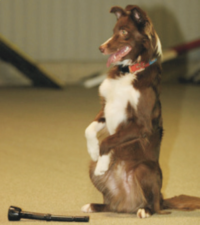 dive inside to steal his toys? If so just zip the zipper back up and wait. You may need to zip and unzip the zipper several times before he realizes this is the same self control gig he did with his cookies. Work towards picking up the toy, praising him and then telling him to “get it”. Now walk around with the toy in your hand. Any attempt by the dog to steal the toy, without being invited, is a poor choice and the chance for reinforcement will end. Stop walking, take the dog by his collar and hold him against your leg until he drops the toy. You are controlling the consequences and not allowing him to play. Now keep walking with the toy dangling in sight. Do not pull the toy out of the dog’s reach as you would be eliminating any choice for him and any opportunity to learn the appropriate way to respond.
dive inside to steal his toys? If so just zip the zipper back up and wait. You may need to zip and unzip the zipper several times before he realizes this is the same self control gig he did with his cookies. Work towards picking up the toy, praising him and then telling him to “get it”. Now walk around with the toy in your hand. Any attempt by the dog to steal the toy, without being invited, is a poor choice and the chance for reinforcement will end. Stop walking, take the dog by his collar and hold him against your leg until he drops the toy. You are controlling the consequences and not allowing him to play. Now keep walking with the toy dangling in sight. Do not pull the toy out of the dog’s reach as you would be eliminating any choice for him and any opportunity to learn the appropriate way to respond.
ItsYerChoice should be the foundation of all of your distraction work. Build the game slowly starting with lower value distractions and working your way up to the tougher ones. Once you have worked through food and toys try favourite people or dogs moving. The game is the same for rewards like playing in the hose or going for a swim just as it is for certain favourite pieces of agility equipment. The dog should not leave you at any time to seek his own rewards. Build upon success but be able to control access to that which reinforces your dog so you don’t find yourself in a situation where you blurt out an inadvertent “leave- it!”. A dog that has been trained this way is a joy to work. You do not need to worry about him seeing something or someone he may ‘want’ as he has been taught to make the correct choice on his own and he has complete control over his own impulses regardless of the challenges you present for him.
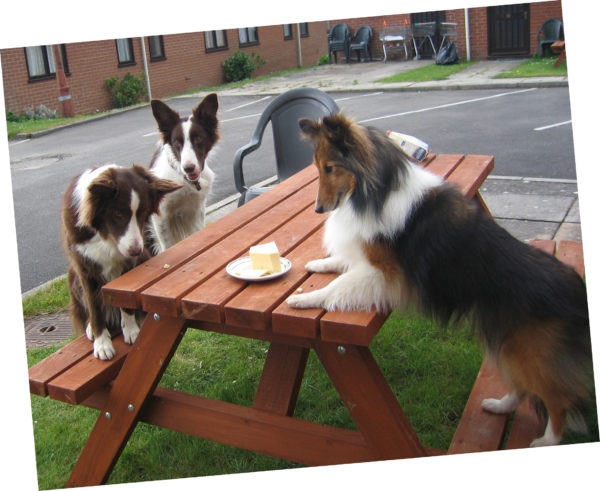
Get Your Free eBook
To receive the complete game in downloadable eBook format, leave your name and email address and we will send it along to you.


